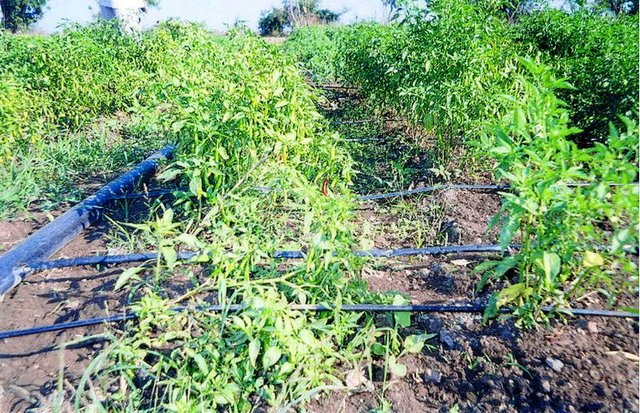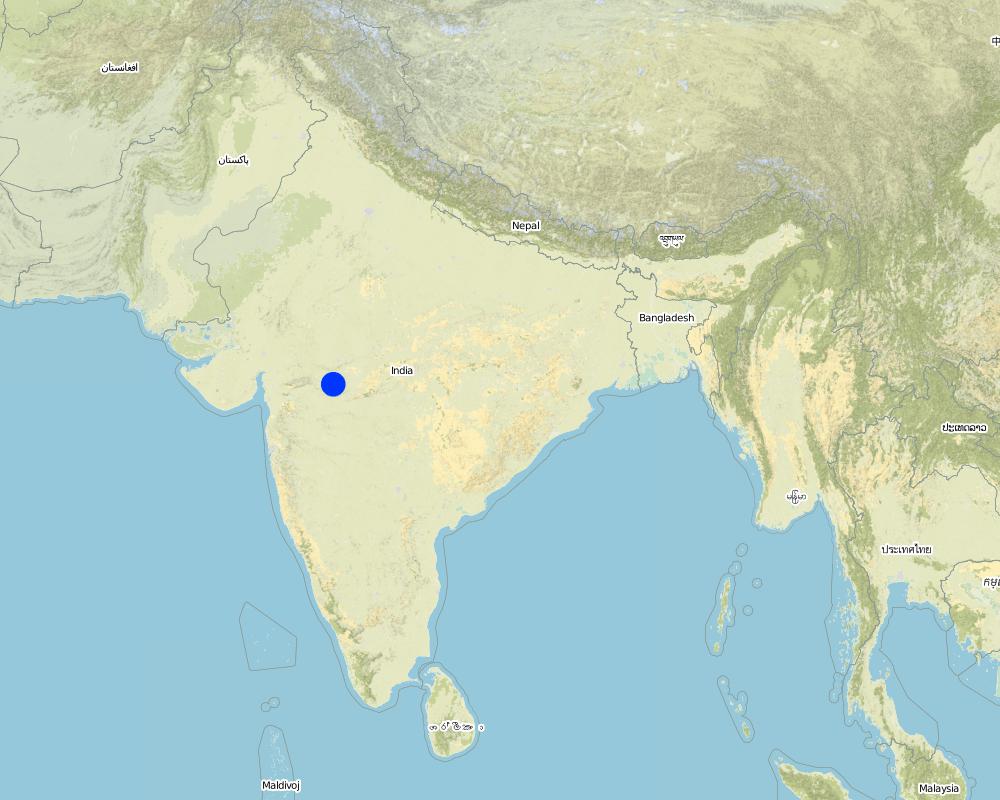Market support and branding for input quality (Krishak Bandhu) [อินเดีย]
- ผู้สร้างสรรค์:
- การอัพเดท:
- ผู้รวบรวม: Shilp Verma
- ผู้เรียบเรียง: –
- ผู้ตรวจสอบ: Fabian Ottiger, Deborah Niggli
approaches_2369 - อินเดีย
ดูส่วนย่อย
ขยายทั้งหมด ย่อทั้งหมด1. ข้อมูลทั่วไป
1.2 รายละเอียดที่ติดต่อได้ของผู้รวบรวมและองค์กรที่เกี่ยวข้องในการประเมินและการจัดเตรียมทำเอกสารของแนวทาง
ผู้เชี่ยวชาญ SLM:
Sadangi Amitabha
amitabha@ide-india.org
International Development Enterprises - India
C 5/43, Safdurjang Development Area (1st & 2nd Floor), New Delhi 110016
บริติชอินเดียนโอเชียนเทร์ริทอรี
ชื่อของโครงการซึ่งอำนวยความสะดวกในการทำเอกสารหรือการประเมินแนวทาง (ถ้าเกี่ยวข้อง)
Book project: where the land is greener - Case Studies and Analysis of Soil and Water Conservation Initiatives Worldwide (where the land is greener)ชื่อของโครงการซึ่งอำนวยความสะดวกในการทำเอกสารหรือการประเมินแนวทาง (ถ้าเกี่ยวข้อง)
International Development Enterprises - India (iDE-India) - สหรัฐอเมริกาชื่อของโครงการซึ่งอำนวยความสะดวกในการทำเอกสารหรือการประเมินแนวทาง (ถ้าเกี่ยวข้อง)
IWMI International Water Management Institute (IWMI) - อินเดีย1.3 เงื่อนไขที่เกี่ยวข้องกับการใช้ข้อมูลที่ได้บันทึกไว้ผ่านทาง WOCAT
ผู้รวบรวมและวิทยากรหลักยอมรับเงื่อนไขเกี่ยวกับการใช้ข้อมูลที่ถูกบันทึกผ่านทาง WOCAT:
ใช่
1.4 การอ้างอิงถึงแบบสอบถามเรื่องเทคโนโลยี SLM

Pepsee micro-irrigation system [อินเดีย]
A grassroots innovation that offers most of the advantages of conventional micro-irrigation at a much lower establishment cost.
- ผู้รวบรวม: Shilp Verma
2. คำอธิบายของแนวทาง SLM
2.1 การอธิบายแบบสั้น ๆ ของแนวทาง
Market development and support through use of a brand name - Krishak Bandhu ('the farmer's friend') - to help ensure quality amongst manufacturers and suppliers of drip irrigation equipment.
2.2 การอธิบายอย่างละเอียดของแนวทาง
การอธิบายอย่างละเอียดของแนวทาง:
Aims / objectives: Poor smallholder farmers are generally slow in adopting new technologies, especially when such decisions require relatively large initial investments which only yield returns over a long period of time. Even when subsidies are made available, the high transaction costs act as a hindrance. After more than three decades of promotion by government, and despite subsidies as high as 90%, conventional drip irrigation technology remains exclusively popular amongst 'gentlemen' (better-off) farmers in India. Since it was first introduced in the 1970s, the total area under drip irrigation expanded sluggishly from 1,500 ha in 1985 to 225,000 ha in 1998, which is tiny compared to an estimated national potential of 10.5 million hectares.
Methods: IDE, India (IDEI) is an NGO dedicated to troubleshooting such problems through a unique market development approach. IDEI promotes simple, affordable, appropriate and environmentally sound technologies for poor smallholder farmers through private marketing channels, under the brand name Krishak Bandhu. Donor resources are accessed by IDEI to stimulate markets by creating demand for such technologies and by ensuring an efficient supply chain for the equipment. The key to the IDEI approach lies in its adoption and application of commercial business principles as well as in its path of socio-economic development as a tool to sustainability of programmes. IDEI seeks to create a strong and continuing demand by motivating and nurturing an effective supply chain (including manufacturers, dealers and assemblers of micro irrigation equipment). In West Nimar, Madhya Pradesh (as in the whole of India) IDEI supports the marketing of cheap, good quality equipment for so-called 'Affordable Micro-Irrigation Technologies' (AMIT) such as pepsee (see associated technology). The promoted technology in this case is based on a farmer's innovation, which then was promoted and spread by IDEI.
Stages of implementation: IDEI has intervened in four major ways: (1) technically it has further developed the local innovation, pepsee, and come up with an improvement, aptly named 'Easy Drip'; (2) it has promoted small manufacturers of drip irrigation equipment and associated them with a brand name; (3) it has trained and supported private sector 'service providers' to assist farmers to install and adopt the systems; (4) on an ad hoc basis, IDEI commissions and supports studies on uptake and impact. Technologies promoted by IDEI provide returns on investment of at least 100% in one year which is crucial in explaining the success of pepsee. Within five years the projects supported by IDEI should become self-sustaining.
2.5 ประเทศ ภูมิภาค หรือสถานที่ตั้งที่ได้นำแนวทางไปใช้
ประเทศ:
อินเดีย
ภูมิภาค/รัฐ/จังหวัด: :
Madhya Pradesh
ข้อมูลเฉพาะเพิ่มเติมของสถานที่ตั้ง:
West Nimar
Map
×2.7 ประเภทของแนวทาง
- ใช้โครงงานหรือแผนงานเป็นฐาน
2.8 เป้าหมายหรือวัตถุประสงค์หลักของแนวทาง
To bring affordable and appropriate water saving technologies to the rural poor through creating effective supply chains and developing markets, under a brand name associated with reliability.
The SLM Approach addressed the following problems: An underlying problem of increasing growing groundwater scarcity combined with the high investment costs of conventional drip irrigation equipment. On top of this is the reluctance of smallholder farmers to take government subsidies because of the high transaction costs (not easy to access; long delays and the reluctance to adopt new technologies). Local and cheap technological options are available, but quality and marketing channels are not assured.
2.9 เงื่อนไขที่เอื้ออำนวยหรือเป็นอุปสรรคต่อการนำเทคโนโลยีภายใต้แนวทางนี้ไปปฏิบัติใช้
บรรทัดฐานและค่านิยมทางสังคม วัฒนธรรม ศาสนา
- เป็นอุปสรรค
Poor consumers are averse to risk and prefer to emulate the success of early-adopters. Hence, there's often a lag period between the introduction of the technology and its poverty impact.
Treatment through the SLM Approach: Every project should become self-sustaining within five years. IDEI therefore establishes the supply chain for manufacturing,IDEI therefore establishes the supply chain for manufacturing,IDEI therefore establishes the supply chain for manufacturing,distri
การมีไว้ให้หรือการเข้าถึงแหล่งการเงินและบริการ
- เป็นอุปสรรค
Private business decisions are based on profit margins and volumes and the often fragmented and cash-starved customers do not constitute an attractive market on their own.
Treatment through the SLM Approach: IDEI develops and nurtures the market for low-cost smallholder friendly technologies; thereby providing incentives to private businesses by encouraging growth in the size of the market.
อื่นๆ
- เป็นอุปสรรค
economic: Poor consumers cannot make large investments and may even be willing to pay a higher per unit price as long as the one-time investment is lowered.
Treatment through the SLM Approach: IDEI identifies and develops appropriate technologies that have high poverty-alleviation potential, are produced locally; are environment friendly; and provide return on investment of at least 100% in one year.
3. การมีส่วนร่วมและบทบาทของผู้มีส่วนได้ส่วนเสียที่เกี่ยวข้อง
3.1 ผู้มีส่วนได้ส่วนเสียที่เกี่ยวข้องในแนวทางนี้และบทบาท
- ผู้ใช้ที่ดินระดับท้องถิ่นหรือชุมชนระดับท้องถิ่น
Smallholder farmers
Traditionally, irrigation investments in particular, and farming in general, has been male-dominated. However, recent studies indicate that women play a critical role in the decision-making process, as these investments often compete with other household requirements.
- ผู้เชี่ยวชาญ SLM หรือที่ปรึกษาการเกษตร
- รัฐบาลแห่งชาติ (ผู้วางแผน ผู้ทำการตัดสินใจ)
- องค์การระหว่างประเทศ
3.2 การเกี่ยวข้องของผู้ใช้ที่ดินระดับท้องถิ่นหรือชุมชนระดับท้องถิ่นในช่วงต่างๆของแนวทาง
| ความเกี่ยวข้องของผู้ใช้ที่ดินระดับท้องถิ่นหรือชุมชนระดับท้องถิ่น | ระบุผู้ที่มีส่วนเกี่ยวข้องและอธิบายกิจกรรม | |
|---|---|---|
| การริเริ่มหรือการจูงใจ | ปฏิสัมพันธ์ | |
| การวางแผน | ไม่ลงมือ | IDEI carrying out awareness creation etc |
| การดำเนินการ | ไม่ลงมือ | |
| การติดตามตรวจสอบหรือการประเมินผล | ไม่ลงมือ | market surveys, studies, assessments initiated and carried out by IDEI |
| Research | ไม่ลงมือ | planned and carried out by IDEI |
3.3 แผนผังแสดงขั้นตอนการทำงาน (ถ้ามี)
คำอธิบาย:
left: Supply channels of AMIT (Affordable Micro-Irrigation Technologies) systems and the role of IDEI right: Key elements of the AMIT marketing strategy
3.4 การตัดสินใจเลือกใช้เทคโนโลยี SLM
ระบุผู้ที่ทำการตัดสินใจเลือกเทคโนโลยีมากกว่าหนึ่งวิธีไปปฏิบัติใช้:
- ผู้ใช้ที่ดินเพียงผู้เดียว ( ริเริ่มด้วยตัวเอง)
การอธิบาย:
on the basis of their specific requirements.
Decisions on the method of implementing the SLM Technology were made by mainly by land users supported by SLM specialists. Mainly by land users supported by specialists/'service providers' (IDEI, the supporting NGO)
4. การสนับสนุนด้านเทคนิค การสร้างขีดความสามารถ และการจัดการด้านความรู้
4.1 การสร้างขีดความสามารถ / การอบรม
ได้มีการจัดอบรมให้แก่ผู้ใช้ที่ดินหรือผู้มีส่วนได้ส่วนเสียคนอื่น ๆ หรือไม่:
ใช่
หัวข้อที่พูด:
Training and extension are combined: while there are no dedicated training courses, through the network of service providers (who have been trained by IDEI), know-how on drip irrigation is spread among adopter and potential adopter farmers. Brochures and pamphlets (several in the local language) are circulated and there is an informative website.
4.3 การเสริมความแข็งแกร่งให้กับสถาบัน (การพัฒนาองค์กร)
สถาบันได้รับการจัดตั้งขึ้นมาหรือเสริมความแข็งแกร่งโดยแนวทางนี้หรือไม่:
- ใช่ อย่างมาก
ระบุระดับของสถาบันที่ได้รับการเสริมความแข็งแกร่งหรือจัดตั้งขึ้นมา:
- ท้องถิ่น
- see Annex A3
4.4 การติดตามตรวจสอบและประเมินผล
การติดตามตรวจสอบและประเมินผลเป็นส่วนหนึ่งของแนวทางหรือไม่:
ใช่
ความคิดเห็น:
bio-physical aspects were regular monitored through measurements; indicators: improvement in water-use efficiency
technical aspects were regular monitored through measurements; indicators: appropriateness of the technology to different crops and locations; also trying out technologies with new crops
socio-cultural aspects were regular monitored through observations; indicators: impact on women and on the poor
economic / production aspects were regular monitored through measurements; indicators: returns vis-à-vis investments
area treated aspects were regular monitored through measurements; indicators: total scale of adoption; IDEI's estimates suggest that their technologies have so far reached 30'000 families
There were None changes in the Approach as a result of monitoring and evaluation: IDEI carries out a number of studies to investigate the impact of their technologies and the scale and dynamics of adoption. The results of these studies feed into their strategic and operational plans. For example, IDEI was the first to introduce drips in mulberry cultivation in Kolar. That became a huge success story.
4.5 การวิจัย
การวิจัยเป็นส่วนหนึ่งของแนวทางหรือไม่:
ใช่
ให้ข้อมูลเพิ่มเติมและให้ระบุผู้ทำการวิจัย:
Apart from research carried out by scientists (published in journals etc) IDEI has its own series of research reports which present the results of various studies on promotion and impact of low cost water saving technologies conducted (see references).
5. การสนับสนุนด้านการเงินและวัสดุอุปกรณ์
5.1 ระบุงบประมาณประจำปีสำหรับแนวทาง SLM นี้
แสดงความคิดเห็น (แหล่งของการระดมทุน ผู้บริจาคคนสำคัญ):
Approach costs were met by the following donors: international non-government (Donor agencies): 100.0%
5.2 การสนับสนุนด้านการเงิน / วัสดุอุปกรณ์ให้แก่ผู้ใช้ที่ดิน
ผู้ใช้ที่ดินได้รับการสนับสนุนด้านการเงิน / วัสดุอุปกรณ์ไปปฏิบัติใช้เทคโนโลยีหรือไม่:
ไม่ใช่
5.3 เงินสนับสนุนสำหรับปัจจัยนำเข้า (รวมถึงแรงงาน)
- ไม่มี
ถ้าแรงงานโดยผู้ใช้ที่ดินเป็นปัจจัยนำเข้าที่มีอยู่มากมาย ระบุด้วยว่าเนื่องจาก:
- สมัครใจ
ความคิดเห็น:
No incentives to support labour are given to land users. IDEI supports the whole chain from manufacturers and dealers to assemblers
5.4 เครดิต
มีการจัดหาเครดิตมาให้ภายใต้แนวทาง SLM หรือไม่:
ไม่ใช่
6. การวิเคราะห์ผลกระทบและการสรุป
6.1 ผลกระทบของแนวทาง
ช่วยให้ผู้ใช้ที่ดินนำเอาเทคโนโลยี SLMไปใช้และบำรุงรักษาสภาพไว้ได้หรือไม่:
- ไม่ใช่
- ใช่ เล็กน้อย
- ใช่ ปานกลาง
- ใช่ อย่างมาก
The widespread adoption of the pepsee and Easy Drip irrigation infrastructure has greatly improved water use efficiency
6.3 ความยั่งยืนของกิจกรรมของแนวทาง
ผู้ใช้ที่ดินสามารถทำให้สิ่งต่างๆ ที่ได้ปฏิบัติใช้โดยแนวทางนี้ยั่งยืนได้หรือไม่ (โดยไม่มีการสนับสนุนจากภายนอก):
- ไม่แน่ใจ
ถ้าตอบว่าไม่หรือไม่แน่ใจ ให้ระบุและแสดงความคิดเห็น :
Entire approach relies on creation of markets which are initially promoted and supported by IDEI. Too early to say whether the market would be sustained after IDEI withdraws but because of the fact that pepsee was a grassroots innovation and emerged spontaneously, there is a good chance. IDEI keeps a five year horizon for its intervention, and targets that market becoms self-sustaining afterwards.
6.4 จุดแข็งและข้อได้เปรียบของแนวทาง
| จุดแข็ง / ข้อได้เปรียบของแนวทางในทัศนคติของผู้รวบรวมหรือวิทยากรหลัก |
|---|
| IDEI believes in the essential dignity of people and their capacity to overcome social and economic pressures, problems and exploitations. It therefore treats poor farmers as customers and not recipients of charity. It applies business models to achieve development by tapping and developing small enterprises in the rural economy and creating markets. |
| It applies business models to achieve development by tapping and developing small enterprises in the rural economy and creating markets (How to sustain/ enhance this strength: Further promote market creation and then let the market forces take off on their own.) |
| The IDEI market creation approach to development ensures that there is awareness and availability of low-cost products that will have a high poverty alleviation impact (How to sustain/ enhance this strength: Ditto) |
| Growth in this approach will take place if the supply chain is performing and profitable. The early adopters may not be the poorest but if the product meets the needs of the farmers, the rural poor will follow suit and considerable market growth could result, creating a sustainable supply channel (How to sustain/ enhance this strength: Ditto) |
6.5 จุดอ่อน / ข้อเสียเปรียบของแนวทางและวิธีในการแก้ไข
| จุดอ่อน / ข้อเสียเปรียบในทัศนคติของผู้ใช้ที่ดิน | สามารถแก้ไขปัญหาได้อย่างไร |
|---|---|
| IDEI needs to work more closely with the government agencies. While market creation seems to be a very useful model, it needs to tap the government resources which are pumped every year in the business of promotion of drip irrigation. |
| จุดอ่อน / ข้อเสียเปรียบในทัศนคติของผู้รวบรวมหรือวิทยากรหลัก | สามารถแก้ไขปัญหาได้อย่างไร |
|---|---|
| IDEI's reach is dependent on its ability to access donor funds. This might become a limitation at some stage. |
7. การอ้างอิงและการเชื่อมต่อ
7.1 วิธีการหรือแหล่งข้อมูล
- ไปเยี่ยมชมภาคสนาม การสำรวจพื้นที่ภาคสนาม
- การสัมภาษณ์กับผู้ใช้ที่ดิน
7.2 การอ้างอิงถึงสิ่งตีพิมพ์
ชื่อเรื่อง ผู้เขียน ปี ISBN:
IDEI Affordable Micro Irrigation Technologies: Marketing Manual. International Development Enterprises, USA.Phansalkar, S.J. (2003). Appropriate Drip Irrigation Technologies Promoted by IDEI: A Socio-Economic Assessment. International Development Enterprises, India (IDEI),Verma, S., Tsephal, S. and Jose, T. (2004). Pepsee Systems: Grassroots Innovation under Groundwater Stress. Water Policy,
ชื่อเรื่อง ผู้เขียน ปี ISBN:
Phansalkar, S.J. (2003). Appropriate Drip Irrigation Technologies Promoted by IDEI: A Socio-Economic Assessment. International Development Enterprises, India (IDEI),
ชื่อเรื่อง ผู้เขียน ปี ISBN:
Verma, S., Tsephal, S. and Jose, T. (2004). Pepsee Systems: Grassroots Innovation under Groundwater Stress. Water Policy,
ลิงก์และโมดูล
ขยายทั้งหมด ย่อทั้งหมดลิงก์

Pepsee micro-irrigation system [อินเดีย]
A grassroots innovation that offers most of the advantages of conventional micro-irrigation at a much lower establishment cost.
- ผู้รวบรวม: Shilp Verma
โมดูล
ไม่มีโมดูล



